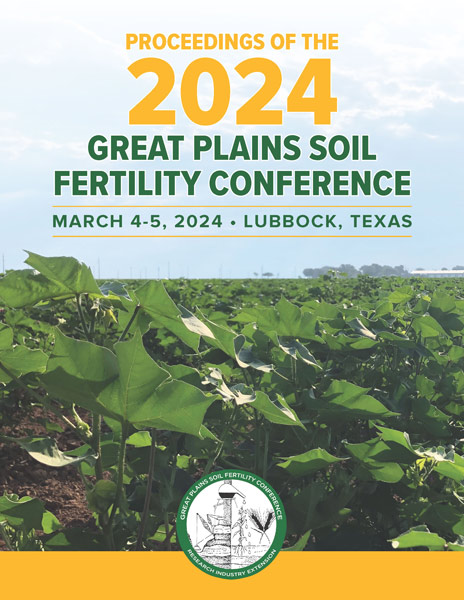Conference Proceedings Available!
Proceedings
Authors
| Filter results8 paper(s) found. |
|---|
1. Assessment of Long-term Effects of Tillage and Nitrogen Management Practices on Irrigated Corn Yields and Nitrogen Use EfficienciesCorn grain yields and crop nitrogen uptake are affected by management factors such as tillage intensity and nitrogen rates. Additional data about the long-term effects of tillage and nitrogen rates on yields and nitrogen use efficiencies of irrigated corn are needed. We are presenting preliminary results from a 17-year study about the effects of these management practices on irrigated corn yields and nitrogen uptake in a Fort Collins clay loam soil at Colorado State University’s Agricultural... J.A. Delgado, A. Halvorson, A. Villacis-aveiga, S. Del grosso, C. Stewart, D. Manter, J. Alwang, B. Floyd, R. D'adamo, G. Miner |
2. Soil Phosphorus Fractions After Long-term Fertilizer Placement in Different Kansas SoilsPhosphorus fertilizer placement can affect the long-term dynamics and forms of P, and the overall soil P pools. These changes can vary by soil type, and affect P uptake and use efficiency by crops. The objective of this study was to evaluate the changes in the labile P fractions in three Kansas soil under P fertilizer placements (broadcast versus deep band) after 10 years of crop rotation. Three field studies were conducted for 10 years from 2006 to 2015 in three different soils... M. Arruda, D. Ruiz diaz |
3. Nitrogen Managememt in Dryland Winter Wheat to Improve Grain Yield and ProteinMaximizing the yield along with adequate protein content in winter wheat is an emerging challenge for dryland wheat producers. Proper nitrogen (N) management with optimization of fertilizer application rate and timing might be a potential strategy to improve grain yield and protein. The objective of the study was to evaluate the effects of different N rates and application timing on grain yield and protein content of hard red winter wheat in Nebraska. Field study was carried out at four locations... D. Ghimire, B. Maharjan |
4. Evaluating the Trade-offs of Cover Crops in Dryland Wheat Systems of the Colorado PlateauOn the semi-arid Colorado Plateau, dryland farmers are challenged by severely degraded soils and low and increasingly unreliable precipitation. Cover crops have been shown to improve soil fertility and mitigate soil erosion in many regions, but are also associated with use of limited soil moisture, a cost that could mean decreased cash crop productivity for farmers. Most literature on cover crops comes from relatively humid climates, where crop yield penalties due to cover crops may be less pronounced.... L. Eash, A. Berrada, K. Russell, S. Fonte |
5. Conservation Management and Nitrogen Fertilization to Enhance Soil Chemical and Biological PropertiesCover crops and no-tillage are increasing in use across Texas. On the Southern High Plains (SHP) these practices are important mitigators of wind erosion and are suggested to increase soil health and other positive soil attributes. This study aimed to monitor and evaluate the soil chemical and biological changes that occur shortly after implementing conservation practices and nitrogen management strategies on the SHP. It was determined that in the short term some soil chemical and biological... M. Mcdonald, P. Delaune, T. Gentry, K. Lewis |
6. Effects of Climate Change and Narrow Rows with Higher Plant Densities on Yields of Irrigated CornClimate change is significantly impacting agricultural systems worldwide, and although there are reports of these impacts contributing to higher yields in some regions, the general consensus is that there will be negative impacts on yields and soil quality across large regions. Management practices that can contribute to higher yields and adaptation to a changing climate will be important during the 21st century. This presentation will cover results from two manuscripts that are currently... J.A. Delgado, B. Floyd, R. D'adamo, A. Villacis, A.D. Brandt, A. Halvorson, C.E. Stewart, J. Alwang, S. Del grosso, D.K. Manter |
7. Soil Health Comparison in Organic and Conventional Cotton-Peanut Rotations in the Texas Plains RegionOrganic farming has been increasingly adopted in the Texas High Plains (THP), but restrictions on synthetic fertilizer use may be problematic if a system cannot mineralize sufficient nutrients from organic matter breakdown to meet crop needs. Cover crops are a tool utilized by both organic and conventional producers for nutrient management, weed control and soil conservation. A one-year study was conducted in organic peanuts in Lubbock and Vernon, TX, to assess the ability of cover crops... N. Boogades, K. Lewis, T. Gentry, P. Delaune, L.M. Ellman-stortz |
8. Sugarbeet Yield Response and Nitrate Leaching As Influenced by Nitrogen Management in Semi-arid ClimateFertilizer nitrogen (N) in irrigated sugarbeet production needs to be optimized to simultaneously increase yield and reduce nitrate leaching. In addition to adjusting N rate and application timing, there are available fertilizer technologies such as controlled- or slow-release N which may be beneficial for beet yield and reducing potential nitrate leaching. However, there are limited studies assessing the effectiveness of such fertilizers for sugarbeet in a semi-arid climate. The two-year experiment... D. Ghimire, B. Maharjan |
